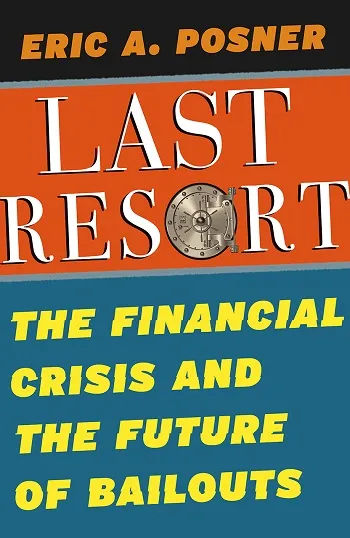Last Resort

Professor Eric Posner has several points to make about the bailouts that took place during the financial crisis 10 years ago. First, the federal government broke the law, multiple times and in a variety of ways. Second, it made the right choice. And third: despite the public’s rage over the loans—and the widespread belief that such rescues inspire future recklessness—the answer is to expand the government’s emergency lending powers so it won’t need to break the law the next time the economy melts down.
And there will be a next time, Posner argues in a new book. The question is whether we’ll be ready.
“Lack of sympathy toward Wall Street, understandable as it may be, has obscured some of the important questions about how the federal government behaved during the bailout,” he writes in Last Resort: The Financial Crisis and the Future of Bailouts (University of Chicago Press). “The illegality of the government’s conduct is tied to the underlying question of what bailout policy should have been, and what it should be in future crises. If we think the government’s illegal actions advanced the public interest, then we’ll need to change the law so that next time around regulators will know what is expected of them.”
In Last Resort, Posner, the Kirkland & Ellis Distinguished Service Professor of Law, examines the legal maneuvering undertaken by the Federal Reserve, the Federal Deposit Insurance Corporation (FDIC), and eventually the Department of Treasury to bail out entities like the insurance corporation AIG, automakers GM and Chrysler, and the government-sponsored mortgage enterprises Fannie Mae and Freddie Mac. The rescues were unprecedented in scope, adding up to hundreds of billions of dollars, and in some cases veered from what was then the understood authority of the Fed and the FDIC—which function as “lenders of last resort” (LLR)—by including unsecured loans to nonbank financial institutions. The bailouts also elicited charges of favoritism because the government treated some institutions more harshly than others. The maneuvering, Posner wrote, included both “questionable interpretations” of the law and outright violations. For instance, he writes, the Fed broke the law when it took nearly 80 percent of AIG’s equity in exchange for an $85 billion loan, and Treasury broke it by seizing equity from Fannie Mae and Freddie Mac.
The legal gymnastics ultimately helped the government bypass obstacles, but it came at a cost. In some cases, the government behaved too cautiously, and in others it structured transactions in unnecessarily complex ways, reducing transparency and raising costs. It also eventually resulted in costly and time-consuming litigation. (Posner does note, however, that contrary to popular belief, the government didn’t actually lose money on the bailout loans and investments—it made money. That profit stood at about $87 billion as of March 22, 2018, according to one estimate.)
Ultimately, Posner calls for legal reforms that expand the powers of the LLR to rescue financial institutions—a position that runs contrary to the post-crisis policy reforms already enacted. The Dodd-Frank Act, which was passed in 2010, was billed as an end to bailouts, and it tries to accomplish that by addressing the root causes of financial crises as well as by attempting to limit the power of government agencies to rescue struggling financial institutions.
The first response makes sense, Posner said. The second part does not—in part because bailouts are inevitable.
“The Dodd-Frank Act will not end bailouts because it cannot prevent financial crises from occurring, and if a financial crisis occurs, bailout is the correct response,” he wrote. “This means that Congress’s second response to the crisis—restrictions on the LLR—was perverse rather than wise.”
Instead, he proposes broadening the powers of the Fed and FDIC beyond the traditional bank model, allowing the LLR to transact with all types of financial institutions, as well as allowing them to seize and control financial institutions under the power of eminent domain (with just compensation), make unsecured and undersecured loans when collateral is unavailable or of low quality, and more. This, however, would require public buy-in.
“At a minimum, [the LLR] needs the powers that the Fed, Treasury, and FDIC used, mostly illegally, during the last financial crisis,” he wrote. “The LLR will be able to survive in a democracy, regardless of how powerful and independent it is, as long as the public believes that it serves the public interest. Depriving it of the powers it needs will not advance that goal.”

